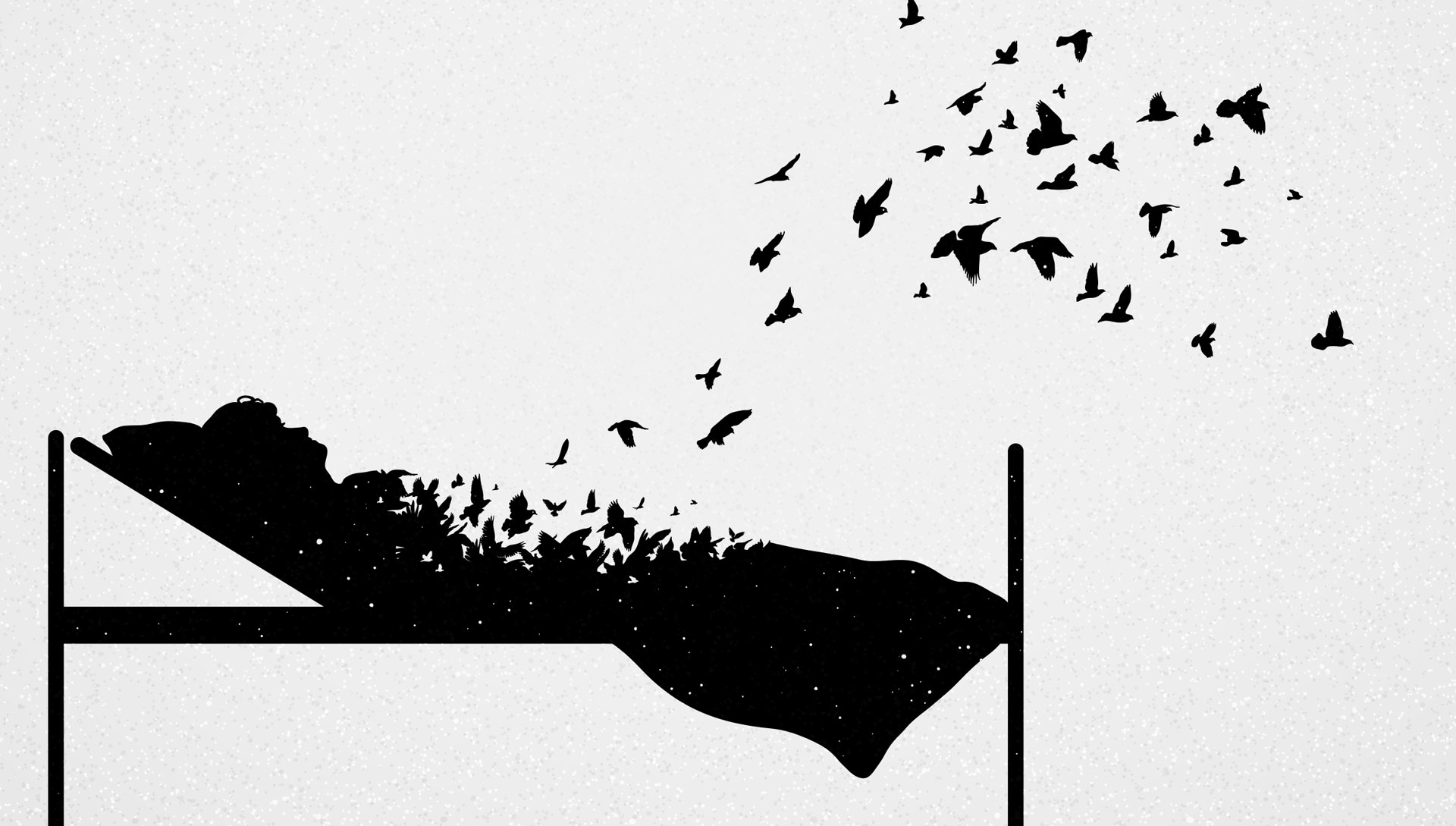Partly because of his work in the UK, GP Maarten Scholten began to think differently about (the purpose of) palliative sedation in recent years. Of course, this is not the only way to die with dignity, as he experienced.
New palliative sedation guidelines from KNMG and IKNL were recently published.1 An important revision, especially as national and international figures show an increasing trend in the use of palliative sedatives. It seems that ‘dying in your sleep’ has become commonplace.
New guidelines and improvements in palliative sedation have prompted me to reflect on the practice of palliative sedation in the Netherlands. A reflection fostered from my personal perspective: trained as a general practitioner in the Netherlands, having completed a master’s degree in palliative care, and working in hospitals in the United Kingdom (UK) since 2020.
Difference in starting point
Twenty years ago I completed my medical studies in Amsterdam. My development as a doctor was shaped after the enactment of the ‘euthanasia law’ in 2002. During this period, euthanasia was widely accepted by the Dutch population and gained an increasingly prominent place in society. Since then, palliative care in the Netherlands has also accelerated and palliative sedation has received more attention. As a general practitioner, it is not unusual for me to apply palliative sedation during the dying phase.
It seems that ‘dying in your sleep’ has become commonplace
Now, twenty years later, my views on the use of euthanasia and palliative sedation have changed. Euthanasia is not legal in the UK and the practice at the hospital where I work is different to what I am used to in the Netherlands. In England we also use sedatives during the dying phase, but almost never with the aim of reducing consciousness. The goal is mainly to relieve symptoms. Low-dose midazolam can help overcome this – due to its anxiolytic and muscle relaxing effects – without causing loss of consciousness. Permanent loss of consciousness (sedation) may occur during dose titration, but is not the primary goal when starting midazolam. Continuous deep sedation leading to death is rare in the UK and only occurs in very exceptional circumstances.
This difference in starting point means that the language and practices surrounding the use of sedation in the dying phase also differ. For example, Seymour and colleagues show that in the Netherlands people talk about ‘putting patients to sleep’.2 In the UK, the emphasis in communication is on administering low doses of sedative medication with the aim of symptom relief (‘calming’). Therefore, the term palliative sedation is rarely used here. Additionally, Seale et al make it clear that in the Netherlands – unlike in the UK – the emphasis is on the specific moment when sedation begins, often preceded by a family meeting at which the parties involved say goodbye to the patient.3
Emotional burden
Therefore, differences in the use of sedatives between the Netherlands and the UK depend mainly on the intention before their use: rapid and continuous deep sedation until death in the Netherlands (‘sleep’) versus proportional sedation aimed at reducing symptoms. tolerable levels in the UK (‘sedentary’). This distinction is relevant for the treating team and for the patient and his loved ones, because at the beginning of continuous deep sedation until death, the patient’s bibliographic life – the life he still experiences consciously – ends. The emotional toll this causes should not be underestimated.
Adequate symptom relief can often be achieved with low-dose sedatives (e.g. midazolam 5-10 mg/24 hours via subcutaneous administration), if necessary, combined with opioids for pain management, and antiemetics for nausea and vomiting. This dose is much lower than the initial dose in step 1 of the step-by-step plan in the revised guidelines. Pharmacological symptom control must go hand in hand with good communication and nursing care (oral hygiene, prevention of constipation, bedsores, etc.) combined with optimal psychosocial support and with attention to existential suffering and questions of meaning. In this way, it seems possible to alleviate suffering during the death phase to a bearable level in almost 100 percent of cases.
Fear of death
Although at first I thought that the Netherlands was an open and progressive country because of the possibility of euthanasia and palliative sedation, I began to feel that there was a downside, as this brought about a change in our relationship with death. Death and the deathbed are then increasingly reduced to a medical problem, which ignores the cultural, social and relational aspects of death, such as closing the life lived, looking back, moving on, forgiving, and so on.
Therefore, when death is discussed, what matters most is how we plan and control it. And when the dying phase appears, people often choose to take matters into their own hands: by euthanasia or dying ‘in their sleep’ through palliative sedation. This picture is confirmed in the article by Heijltjes et al., which describes an increase in requests for sedatives (by patients and/or relatives).4 In this way, everything is done to avoid the feeling (fear) of death and related emotions.
Training and information
I found that working in a UK hospital and the different ways of dealing with the end of life has changed my view of palliative sedation. But despite these differences, there is one thing in common in the dying phase: namely practices aimed at reducing suffering. Various resources are available to us for this, which can be used depending on the context. For me, the most important and surprising lesson was that to give a patient a sense of control and die with dignity, it is not always necessary to resort to methods such as continuous deep sedation or euthanasia. It is good if palliative sedation is available and can be used if indicated, but this is not the only way to die with dignity.
With skilled assisted dying, a dignified death can occur
Therefore, it is important that we provide adequate training to doctors and other health professionals. More attention is needed to palliative care and palliative sedation, especially in basic curricula and nursing internships and training. And more training for general practitioners who are often the implementers. Good information for patients and families regarding normal deaths is also important. We must realize that this is a natural process that cannot be avoided and that it generally occurs gradually and relatively smoothly, without many symptoms or suffering. And with skilled assisted dying and good symptom control – including low-dose midazolam – a dignified death can occur in many cases. I hope that with this we can eliminate some of the ‘fear of death’, so that patients and their relatives ask for deep sedation less often, and doctors decide to do it less often. Palliative sedation can then be used for extreme cases where refractory symptoms occur despite optimal palliative care. Because that is what is meant by palliative sedation, and not the modus operandi of ‘dying in your sleep’.
author
Maarten Scholten, palliative care doctor, Queenscourt Hospice, Southport (UK)
Contact
maarten.scholten@nhs.net
cc: redactie@medischcontact.nl
footnote
[1]Comprehensive Cancer Center Netherlands, 2022. Multidisciplinary guidelines for palliative sedation, revised guidelines 2022. Accessed 23 July 2022. https://palliaweb.nl/getmedia/4852433b-70b3-4e9c-87a1-6b631b4060bb/Multidisciplinary-Richtlijn-Palliatieve- Sedatie-2022 .pdf [2]Seymour, J., Rietjens, J., Bruinsma, S., Deliens, L., Sterckx, S., Mortier, F., Brown, J., Mathers, N., van der Heide, A., & UNBIASED consortium (2015). Continuous sedative use until death for cancer patients: a qualitative interview study of practicing physicians and nurses in three European countries. Palliative Medicine, 29(1), 48–59. https://doi.org/10.1177/0269216314543319 [3]Seale, C., Raus, K., Bruinsma, S., van der Heide, A., Sterckx, S., Mortier, F., Payne, S., Mathers, N., Rietjens, J., & UNBIASED consortium (2015). The language of sedation in end-of-life care: Ethical rationales of service providers in three countries. Health (London, England : 1997), 19(4), 339–354. https://doi.org/10.1177/1363459314555377 [4]Heijltjes, M.T., van Thiel, G., Rietjens, J., van der Heide, A., de Graeff, A., & van Delden, J. (2020). Changing Practices of Continuous Sedation Use at the End of Life: A Systematic Review of the Literature. Journal of pain and symptom management, 60(4), 828–846.e3. https://doi.org/10.1016/j.jpainsymman.2020.06.019
Also read:

“Falls down a lot. General tv buff. Incurable zombie fan. Subtly charming problem solver. Amateur explorer.”








